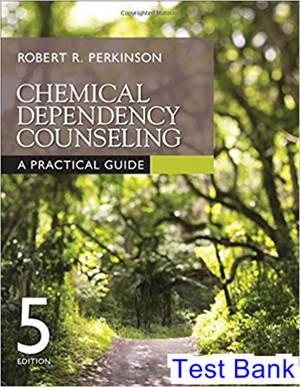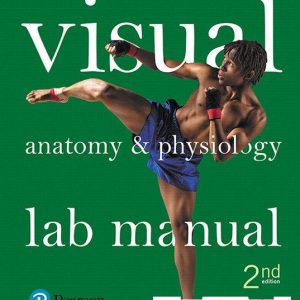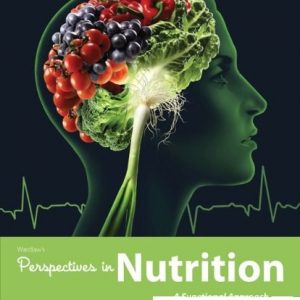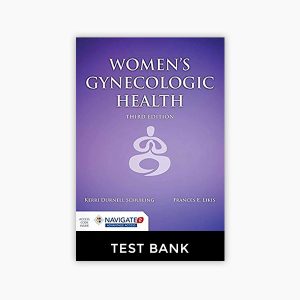Chemical Dependency Counseling A Practical Guide 5th Edition Perkinson Test Bank

Product details:
- ISBN-10 : 1506307345
- ISBN-13 : 978-1506307343
- Author: Robert R. Perkinson
The best-selling Chemical Dependency Counseling: A Practical Guide provides counselors and front-line mental health professionals with the information and skills they need to use evidence-based treatments, including motivational enhancement, cognitive behavioral therapy, skills training, medication, and 12-step facilitation. Guiding the counselor step by step through treatment, author Robert R. Perkinson presents state-of-the-art tools, forms, and tests necessary for client success while meeting the highest standards demanded by accrediting bodies. The Fifth Edition of this landmark text has been updated to include coverage of current topics of concern for counselors, including full compliance with DSM-5, new coverage of steps 6 – 12 in 12-step facilitation, discussions on synthetic and designer drugs, new psychotherapeutic medications, new survey data on patterns of use and abuse, a list of online recovery support groups for clients, and a new section on Recommendations for a Successful First Year in Recovery.
Table contents:
1. First Contact
Treatment Works
The Motivational Interview
How to Assess Motivation
2. First Hours of Treatment
The First Hours
How to Greet Clients
Beginning the Therapeutic Alliance
Dealing With Early Denial
How to Check for Organic Brain Dysfunction
The Initial Assessment
How to Conduct a Crisis Intervention
American Society of Addiction Medicine Patient Placement Criteria
Diagnostic and Statistical Manual
Diagnosis: Substance Use Disorder
How to Determine the Level of Care Needed
Criteria for Outpatient Treatment (Adults)
Criteria for Inpatient Treatment (Adults)
Criteria for Outpatient Treatment (Adolescents)
Criteria for Inpatient Treatment (Adolescents)
The Client’s Reaction to Intoxication
What to Do With an Intoxicated Client
How Clients React in Detoxification
The AMA Threat
How to Develop and Use the AMA Team
How to Use the In-House Intervention
How to Respond to Clients Who Leave AMA
3. Biopsychosocial Interview
The Biopsychosocial Interview
How to Conduct the Interview
A Sample Biopsychosocial Interview
4. Treatment Plan
How to Build a Treatment Plan
The Diagnostic Summary
The Problem List
Goals and Objectives
How to Develop Goals
How to Develop Objectives
How to Develop Interventions
How to Evaluate the Effectiveness of Treatment
How to Select Goals, Objectives, and Interventions
Treatment Plan Review
Documentation
How to Write Progress Notes
Formal Treatment Plan Review
5. Individual Treatment
The Therapeutic Alliance
How to Develop a Therapeutic Alliance
How to Be Reinforcing
How to Use Empathy
Transference and Countertransference
Examples of Empathic Statements
How to Be Confrontive
Behavior Therapy
When a Client Breaks a Rule
Why We Concentrate on Behavior Therapy
Cognitive Therapy
Interpersonal Therapy
How to Choose the Therapeutic Modality
6. Group Therapy
Benefits of the Group Process
Preparation for the Group
The Agenda Group
The Honesty Group
How to End Each Group
The Euphoric Recall Group
The Reading Group
The Relapse Prevention Group
The Spirituality Group
The Childhood Group
Men’s Group/Women’s Group
The Community Group
The Personal Inventory Group
Skills Training Group
Problem-Solving Skills Group
7. Drugs of Abuse
Drugs of Abuse
Alcohol
Alcohol-Induced Organic Mental Disorders
Opioids
Hallucinogens
Cannabis
Inhalants
Nicotine
Club Drugs
Polysubstances
Treatment Outcome
8. Recovery Skills
The Chemical Use History
Honesty
Love, Trust, and Commitment
Feelings
Relationship Skills
Addictive Relationships
Communication Skills
Self-Discipline
Impulse Control
Relapse Prevention
Stress Management
9. Steps
The Committee
Step One
Step Two
Step Three
Step Four
Step Five
Step Six
Step Seven
Step Eight
Step Nine
Step Ten
Step Eleven
Step Twelve
10. Lectures
The Disease Concept
Defense Mechanisms
The Great Lie
Normal Development
Physical Addiction and Recovery
Alcoholics Anonymous
Meetings
Feelings
11. Special Problems
The Psychiatric/Psychological Assessment
How to Develop the Treatment Plan
The Depressed Client
The Angry Client
Personality
The Antisocial Personality
The Borderline Client
The Narcissistic Client
The Anxious Client
Post-Traumatic Stress Disorder
Panic Attacks
The Psychotic Client
Acquired Immune Deficiency Syndrome
The Client With Low Intellectual Functioning
The Client Who Cannot Read
The Elderly Client
The Client With Early Childhood Trauma
Love in the Treatment Center
The Pathological Gambler
12. Adolescent Treatment
The Normal Adolescent
Puberty
Ages 13 to 16
Ages 16 to 19
The Adolescent Chemical Dependency Counselor
The Point System
The Primary Elements in Adolescent Treatment
The Rules
Communication Skills
Honesty
Exercise
Fun in Sobriety
The Reinforcers
Spirituality
Group Therapy
Peer Pressure
Continuing Education
Continuing Care
The Parents Support Group
The Behavioral Contract
Phases of Adolescent Treatment
13. The Family Program
The First Family Contact
How to Handle the Early “Against Medical Advice” Risk
Common Family Problems
How to Treat Family Members
The Family Program Schedule
How to Work With the Family in Group
The Conjoint Session
14. The Clinical Staff
The Physician/Addictionologist
The Psychologist/Psychiatrist
The Social Worker/Mental Health Counselor
The Nurse
The Clinical Director
The Clinical Supervisor
The Chemical Dependency Counselor
The Rehabilitation Technician or Aide
The Recreational Therapist
Clinical Staffing
Team Building
Commitment to Coworkers
Boundaries
Staff–Client Problems
What to Do When a Client Does Not Like a Counselor
What to Do When a Client Complains About a Rule
The Work Environment
15. Discharge Summary and Continuing Care
Outpatient Discharge Criteria
Inpatient Discharge Criteria
How to Develop a Discharge Summary
The Discharge Summary
Saying Good-Bye
16. The Good Counselor
Good Counselors Are Caring
Good Counselors Love Their Work
Good Counselors Do Not Become Overly Involved
Good Counselors Do Not Lie
Good Counselors Are Gentle
Good Counselors Like Themselves
Good Counselors Are Supersensitive
Good Counselors Have a Sixth Sense
Good Counselors Do Not Become Overly Emotional
Good Counselors Are Active Listeners
Good Counselors Do Not Talk Too Much
Good Counselors Maintain Boundaries
Good Counselors Are Client-Centered
Good Counselors Have Effective Relationship Skills
Good Counselors Have a Sound Code of Ethics
Appendix 1. Short Michigan Alcoholism Screening Test (SMAST)
Appendix 2. AUDIT Questionnaire
Appendix 3. CRAFFT Interview
Appendix 4. Biopsychosocial Assessment
Appendix 5. Rethinking Drinking: Alcohol and Your Health
Appendix 6. Alcohol Withdrawal Scale
Appendix 7. Clinical Opiate Withdrawal Scale (COWS)
Appendix 8. DSM-5 Psychoactive Substance Use Disorder
Appendix 9. Daily Craving Record
Appendix 10. Sample Biopsychosocial Interview
Appendix 11. Hamilton Depression Rating Scale
Appendix 12. Step One
Appendix 13. Personal Recovery Plan
Appendix 14. Feelings
Appendix 15. Chemical Use History
Appendix 16. Relapse Prevention
Appendix 17. Codependency
Appendix 18. Anger Management
Appendix 19. Stress Management
Appendix 20. Relationship Skills
Appendix 21. Honesty
Appendix 22. Love, Trust, and Commitment
Appendix 23. Barriers in Thinking
Appendix 24. Self-Discipline
Appendix 25. Communication Skills
Appendix 26. Drug Categories for Substances of Abuse
Appendix 27. Heroin
Appendix 28. National Cancer Institute Guide to Quitting Smoking
Appendix 29. Drug Abuse Screening Test
Appendix 30. Impulse Control
Appendix 31. Addictive Relationships
Appendix 32. Alcohol Abstinence Self-Efficacy Scale
Appendix 33. Step Two
Appendix 34. Step Three
Appendix 35. Step Four
Appendix 36. Step Five
Appendix 37. Psychotherapeutic Medications
Appendix 38. Narcissism
Appendix 39. Hamilton Anxiety Rating Scale
Appendix 40. Post-traumatic Stress Disorder (PTSD) Checklist Civilian Version
Appendix 41. Post-traumatic Stress Disorder (PTSD) Checklist Military Version
Appendix 42. Gambling History
Appendix 43. Pressure Relief Group Meeting and Budget Form
Appendix 44. Honesty for Gamblers
Appendix 45. Step One for Gamblers
Appendix 46. Step Two for Gamblers
Appendix 47. Step Three for Gamblers
Appendix 48. Step Four for Gamblers
Appendix 49. Step Five for Gamblers
Appendix 50. Relapse Prevention for Gamblers
Appendix 51. Adolescent Unit Level System
Appendix 52. Adolescent Unit Point System
Appendix 53. Peer Pressure
Appendix 54. The Behavioral Contract
Appendix 55. Family Questionnaire
Appendix 56. Sample Discharge Summary
Appendix 57. NAADAC Code of Ethics
Appendix 58. Fagerström Test for Nicotine Dependence
Appendix 59. Diagnostic/Integrated Summary
Appendix 60. Mental Health Screening
Appendix 61. Adult Nurses Intake
Appendix 62. Adolescent Nurses Intake
Appendix 63. Adult Inpatient Program Schedule
Appendix 64. Adolescent Inpatient Program Schedule
Appendix 65. Gambling Inpatient Program Schedule
Appendix 66. Adult Outpatient Program Schedule
Appendix 67. Adolescent Outpatient Program Schedule
Appendix 68. Gambling Outpatient Program Schedule
Appendix 69. Day Treatment Program Schedule
Appendix 70. Strengths, Needs, Abilities, and Preferences
References
About the Author





